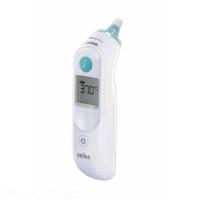Tongue Depressor

To help you make the best choice, feel free to check out our selection on Amazon via this link:
What is a tongue depressor?
A tongue depressor is an essential medical instrument, sterilizable or disposable, resembling a flat wand with rounded ends. It is used by healthcare professionals to examine the inside of the patient's mouth and throat. This simple yet effective tool helps to depress the patient's tongue, allowing a clear view of the throat, tonsils, and palate, thereby facilitating the diagnosis and treatment of various conditions.
Typically made of wood, plastic, or metal, the tongue depressor is designed to be safe, hygienic, and comfortable for medical professionals to use. It is usually rectangular in shape with rounded edges to minimize discomfort during the examination. In the context of oral health, dentists also use it to keep the tongue away during dental procedures.
What are the different types of tongue depressors?
Based on their material of manufacture and usage, tongue depressors can be classified into three types, as follows:
Wooden tongue depressors
Wooden tongue depressors are the traditional and most commonly used type. They are made from untreated wood, typically birch or poplar, which is smooth and splinter-free to ensure patient comfort during examinations. Wooden tongue depressors are usually disposable to maintain hygiene and prevent germ transmission.Plastic tongue depressors
Plastic tongue depressors offer a modern alternative to the wooden version. They are generally more durable and can be sterilized for repeated use, making them cost-effective and environmentally friendly. The plastic used is of medical-grade quality, non-toxic, and tear-resistant. Some plastic models are also designed with an integrated light to illuminate the mouth during examinations.
Disposable tongue depressors
Disposable tongue depressors can be made of wood or plastic. They are designed for single-use to prevent disease transmission. After use, they are properly discarded. Disposable tongue depressors are often used in hospitals, clinics, and medical practices where hygiene is crucial. They are typically individually packaged to ensure sterility until use.
Reusable tongue depressors
Unlike disposable tongue depressors, reusable tongue depressors can be cleaned and sterilized for repeated use, making them more cost-effective and environmentally friendly. They are generally made from durable materials such as high-quality metal or plastic, offering superior strength and durability.
Hygiene and Safety
Sterilization of reusable tongue depressors is a crucial step to ensure hygiene and patient safety. After each use, the tongue depressor should be thoroughly cleaned with water and soap to remove any visible residue. It should then be sterilized to eliminate germs and bacteria. This can be done using an autoclave, a device that utilizes steam under pressure to sterilize medical instruments. Additionally, some plastic tongue depressors can be cleaned and disinfected with a 70% alcohol solution or a diluted bleach solution.
As for disposable tongue depressors, they offer several advantages in terms of hygiene. They eliminate the risk of cross-contamination between patients, as each tongue depressor is used only once and then disposed of. This is particularly important in healthcare settings where the spread of infections must be rigorously controlled.
How to Choose the Right Tongue Depressor?
Choosing the right tongue depressor is essential to ensure accurate and comfortable oral examinations for your patients. Here are some key factors to consider when making your choice:
Material
Wooden models are traditional and disposable, while plastic or metal ones can be sterilized and reused. The choice of material depends on your preference, hygiene needs, and budget.
Reusable vs Disposable
If you prefer a tool that can be sterilized and reused, opt for a plastic or metal tongue depressor. If you want to minimize the risk of cross-contamination and eliminate the need for sterilization, disposable tongue depressors are an excellent choice.
Patient Comfort
The tongue depressor should be soft and smooth to minimize patient discomfort during the examination. Rounded edges and a smooth surface are essential.
Size
Tongue depressors are available in different sizes. Make sure to choose the size that best suits your patients. For example, for children, opt for a smaller tongue depressor.
Quality
Ensure that the device is of good quality and complies with health and safety standards. It should be sturdy, durable, and able to withstand pressure without breaking or deforming.
 Francais
Francais 
 Quote
Quote  Cart
Cart 





